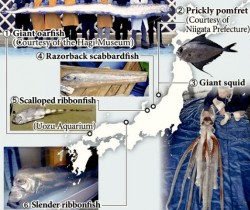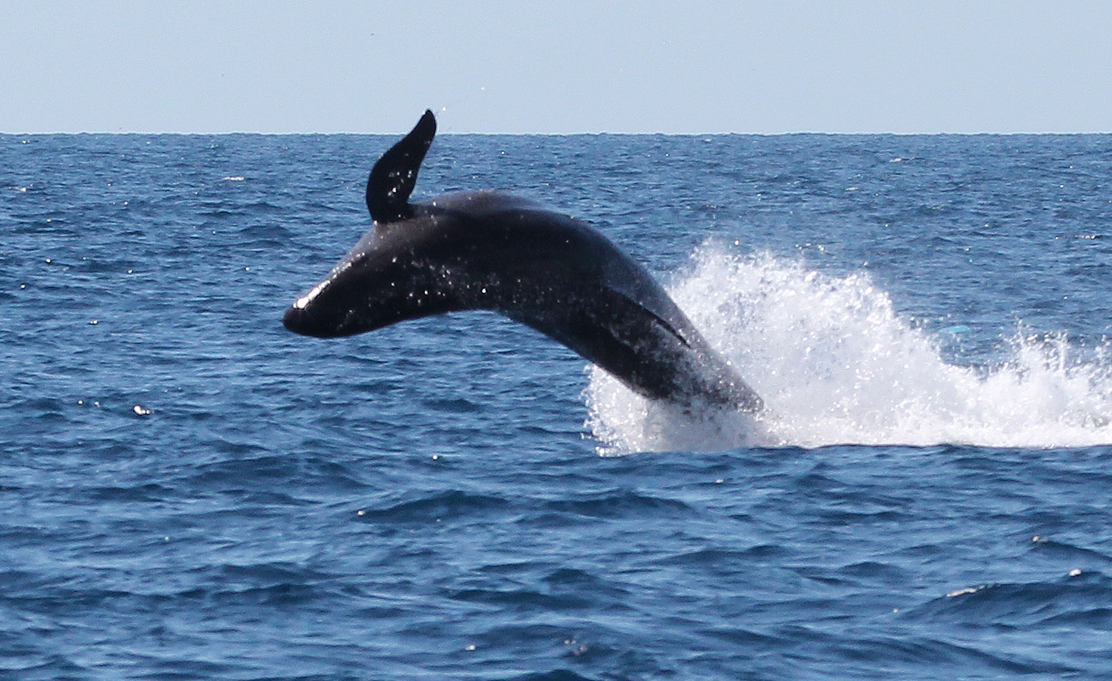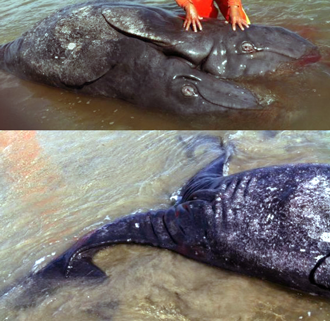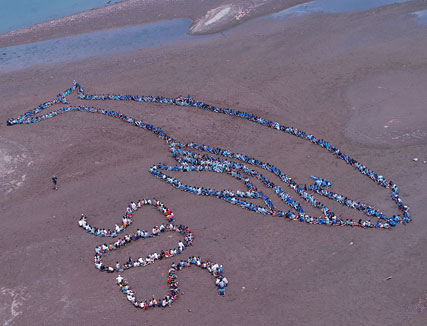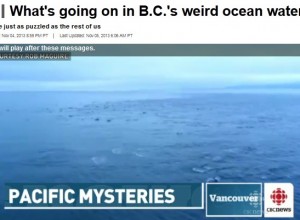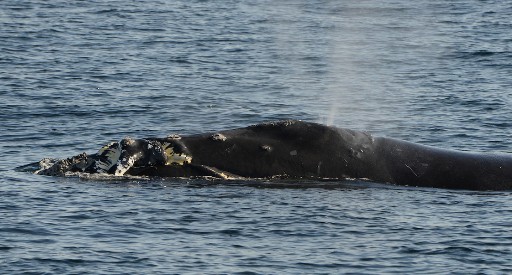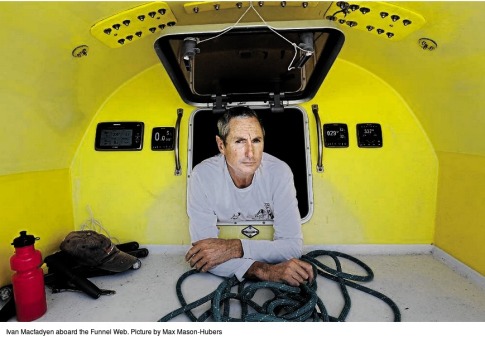America Tonight, Aug. 26, 2014 (emphasis added): A sea lion has washed up… suffering repeated violent seizures, it’s in agony… “We’ve rescued about 860 animals within our rescue range. We’re seeing increased numbers in all the species we’ve cared for this year.” It’s not just sea lions — otters are also dying… large numbers of whales and dolphins are stranding on Southern California beaches, brown pelicans… dropped dead from the sky… “She had been seizing for about 30-40 minutes. Nothing seemed to be helping, so she eventually died while we were doing other stuff in here.”… “The sea lions are the sentinels of the sea. They are eating the fish that the humans are eating… There could be a time… that all the fish are contaminated by this toxin.”
Read moreMass Die-Off Of Whales, Dolphins, Sea Lions, Otters, Birds On U.S. West Coast
Whales
Experts: Scary problems on California coast — There may be “no food anywhere” along Pacific except in isolated areas — “It’s like crime scene investigation” in ocean — ‘Certainly’ Fukushima is one of stresses to sea life — Dolphins, whales more likely to be bathed in radiation (VIDEO)
I’ve posted a link to this article yesterday, but it seems not many people saw it.
So here is the entire article.
Interview with Kristen Milligan(transcript excerpts), Oregon State University marine ecologist, by WheepingWillow, June 13, 2014 (emphasis added):
- 4:30 in — “There‘s other issues going on, like with dolphins and sea lions… There’s all these different stresses happening and certainly Fukushima is one.”
- 8:30 in –” The problems we’re having in Monterey Bay, I think it’s pretty different than the sea star wasting. It is a very similar, heightened — scary, you know. Because the dolphins and sea lions, especially the dolphins, they’re moving way offshore, miles and miles and miles. So those animals are more likely to be bathed in whatever — if there is significant levels of radiation to cause that — they’re more likely to be bathed on a chronic long-term level in that stuff, because they’re out in that… So we’re getting different types of exposure between the marine mammals and starfish. I can’t say anything, because it’s not, and this is where I wish — I’m looking forward to seeing what reports we get from the scientists that are just meeting to assess this… [Sea stars are] not like the big tuna that are starting to show signals of radiation. They’re not like dolphins or whales that are transiting the ocean waters all the time to areas that are closer to Japan.”
Professor: Concerns Fukushima is impacting Alaska; “Unusual animals showing up dead… Seals with unknown disease… first cases of avian cholera” – NOAA: ‘Rare whale beachings’ in Alaska under investigation – Japan Paper: Mysterious sea creatures found one after another along coast (PHOTOS)
Nome Nugget, Mar. 27, 2014: Radiation sampling to happen for Bering Strait — Regional concerns about the possibility that Bering Sea waters could be radioactively contaminated […] “People throughout our region have repeatedly asked for testing of our subsistence foods and water,” said [University of Alaska, Fairbanks professor Gay Sheffield]. “Seals fell sick with a still unknown disease, we’ve had the documented first cases of avian cholera in Alaska, we’ve had unusual animals like the beaked whale showing up dead on the beach near Gambell and each time people throughout the region expressed concerns about the effects of Fukushima either in the air, and now with the approaching plume in the water,” said Sheffield. […] Gambell Tribal President Eddie Ungott agreed and said that his village is very concerned about radiation. […] IRA President Paul Rookok, Sr. said they are worried about the health of marine mammals […]
Over 50 dead seals, sea lions, whales, walrus recently stranded in Alaska – Experts: ‘Marine transported Fukushima radionuclides… may represent a new stressor to ecosystem’
– Over 50 dead seals, sea lions, whales, walrus recently stranded in Alaska — Dozens of seals suffering from baldness, skin sores — Experts: “Marine transported Fukushima radionuclides… may represent a new stressor to ecosystem” (ENENews, May 6, 2014):
Poster for Alaska Marine Science Symposium, Jan. 20, 2014: Based on modeled radionuclide concentrations the dose to Northern Pinnipeds on ice was less than the ERICA risk assessment no-effects level of 10 uGy/hr with the following caveats: 1) Source terms for the Fukushima nuclear accident release vary greatly creating uncertainty in the models. 2) Knowledge gaps exist on extrapolating radiation dose to marine mammals. 3) Exposure to hot particles was not addressed. 4) Cannot rule out that increased radiological exposure in combination with a mixture of other contaminants represented an immunotoxic and thyroid disease risk during the period the animals were living on the ice. 5) Ionizing radiation associated risk for skin defects (i.e. epilation, skin lesions) due to contact and external exposure can also not be excluded. *Marine transported Fukushima radionuclides entering the Bering and Chukchi Seas in the future may represent a new stressor to the ecosystem.
SF Chronicle: ‘Unbelievable hordes’ of fish near California coast; Most birds, sea lions, dolphins, whales anywhere – Expert: ‘Off the charts’ pelican population ‘highly unusual… could reflect breeding failures elsewhere’
San Francisco Chronicle, Apr. 26, 2014: In the past year, Monterey Bay has become the richest marine region on the Pacific Coast. In the past three weeks, it has reached a new peak with unbelievable hordes of anchovies, along with other baitfish, and with it, the highest numbers of salmon, marine birds, sea lions, gray whales, humpback whales and orcas anywhere. The bay ignited with life […] upwelling in the underwater canyon and jump-started the marine food chain. […] A week ago Monday, the humpbacks and killer whales arrived. Tony Lorenz on the Sea Wolf sent me an alert, that he saw 50 humpback whales […] A school of Pacific white-sided dolphin, numbering over a thousand, has also been sighted […] the orcas found a mother gray whale with a calf […] dragged the baby whale below the surface and drowned it […] In the past few days, Lorenz reported another attack, where the orcas dragged a carcass of a baby whale around for hours, and then when a sea lion showed up to see what was going on, it got nailed, too.
Researchers Predict West Coast Killer Whales Will Exceed 1,000 Bq/Kg Of Radioactive Cesium – Over 50 Bq/Kg In Humans Leads To Irreversible Lesions In Vital Organs
Flashback:
THE END.
– Researchers predict west coast killer whales will exceed 1,000 Bq/kg of radioactive cesium — Over 10 times gov’t limit in Japan — Concern about harm to humans, sea life — Expert: People eating large amounts of fish may have levels similar to whales (ENENews, March 18, 2014):
Seattle Post-Intelligencer, Mar. 12, 2014: Ocean currents are driving those nuclear particles […] from Japan to our coastline, and more radiation is likely to be dumped into the ocean […] there is concern that the accumulation, especially of the long-lasting cesium-137, will eventually be harmful to sea life and us. […] certain models “suggest that in 30 years, Cesium 137 levels in (killer) whales will exceed the Canadian guideline of 1,000 becquerels per kilogram for consumption of seafood by humans — 10 times the Japanese guideline.” Scientists focus on whales because, like us, they are at the top of the food chain and eat a lot of fish. So, radiation levels in them is something like a “canary in a coal mine” for radiation pollution.
‘Ultra-Rare’: Up To 70 Endangered False Killer Whales By California Coast
False killer whale ‘Gandalf’:
“They have destroyed Japan and are continuously contaminating the Pacific. We have tried to escape but cannot walk over land. The ocean vibrates, radiation… radiation in the deep. We cannot get out. A shadow lurks in the dark. We can not get out… they (radioactive particles) are coming.”
Corona Del Mar Today, Mar. 13, 2014: False killer whales are members of the dolphin family and are listed as endangered […] “According to the news, these are so rare that they haven’t been seen in Southern California for well over a decade,” [Sgt. John Hollenbeck] said. “They were traveling in a pod of perhaps 50 or so, spread out over about a quarter of a mile. They were very noisy. I could hear them whistling and singing to each other through the hull of my boat as they passed around me. I’ve heard that many times before before with common dolphins, but these were much louder. Initially, I didn’t even realize it was their song – I thought there was something wrong with the engine on my boat.”
Pete Thomas Outdoors, Mar. 13, 2014: [There were] between 50 and 70. […] [Capt. Dave Anderson] managed not only to capture close-ups of the false killer whales, but vocalizations […] including one that seemed to be speaking to the camera. “I’ve never seen anything like it,” Anderson said. “I was sitting there for about five minutes and the whales came over and surrounded me. Their whistles were so loud I could hear them above the surface.”
Read more‘Ultra-Rare’: Up To 70 Endangered False Killer Whales By California Coast
Fukushima Explains Unprecedented Concentrations Of Whales And Other Sea Life Clustered Just Off West Coast
RIA Novosti, Jun 15, 2011: Ocean currents ultimately carry this radioactive material to N. America
Jeff Feldner, Oregon Sea Grant Extension (NOAA) fisheries specialist (at 2:30 in): It’s probable that, for one thing, a lot of the larger animals got out of there quickly. The other thing is that I suspect animals, like whales for instance, I think they would probably be able to tell that something was wrong. They’re very, very intelligent animals. They’re not going to just wait until they start to die off. I think they’re probably likely going to voluntarily gotten out of the area.
Radioactive material has been flowing into the Pacific since the Fukushima disaster began 3 years ago. Scientists say its leading edge made it across the ocean by Summer 2013. Soon after, reports began to appear about unprecedented concentrations of large marine animals congregating close to shore along the west coast:
Dec. 21, 2013: “Unprecedented activity” near Canada’s West Coast: Whales in record numbers, displaying highly unusual behavior — Expert: Problems in Pacific could be bringing sea life to area; “Something’s amiss out there”
Nov. 30, 2013: Whale Expert near Vancouver: In 30 years I’ve never ever seen this kind of behavior, “They must sense this is a safe place to be” — Captain: I’ve never seen anything like it in 50 years on Pacific — “One even placed its head on the boat” (VIDEO)
Problems with killer whales local to West Coast — Only baby born in 2013 died — Just two born in 2012 — Depleted fish supply blamed
– TV: Problems with killer whales local to West Coast — Only baby born in 2013 died — Just two born in 2012 — Depleted fish supply blamed (ENENews, Jan 22, 2014):
KCET, Jan. 21, 2014: With just 81 individuals left, a population of killer whales (a.k.a. orcas) local to the West Coast has been listed as a federally Endangered species since 2005. Now, new data on the beleaguered whales’ habits is prompting a wildlife protection group to ask for better protection of orca habitat along more than half the U.S. Pacific coast — including more than a third of the California coast. […] Southern Resident orcas will eat chum and coho salmon, as well as herring and rockfish, but they strongly prefer the larger Chinook salmon, which may make up as much as four fifths of their diet. And that means that protecting California salmon and their offshore habitat may well be crucial to the health of two of the Southern Resident orca’s three pods, especially in a drought year that may be devastating to California’s Chinook population. Southern Resident orcas may already be feeling the effects of drought, as well as other factors depleting fish stocks off the Pacific coast. Only two calves were born to the population in 2012, and 2013?s sole new calf died before the year was out.
Conjoined Baby Gray Whales Found On West Coast Of N. America – Could Be First Ever Recorded — 2 Heads And 2 Tails, Joined In Middle (Video & Photo)
– Agency: Dead Conjoined Baby Gray Whales found on West Coast of N. America — Could be first ever recorded — 2 heads and 2 tails, joined in middle (PHOTOS & VIDEO) (ENENews, Jan 7, 2014):
Pete Thomas Outdoors, Jan.6, 2014: Scientists find conjoined gray whale calves in Baja California lagoon; discovery could be a first[…] It might be the first documented case of conjoined twin gray whales. […] A database search at the Natural History Museum of Los Angeles County did not reveal published instances of conjoined gray whale twins, or what might also be referred to as Siamese gray whale twins […] Alisa Schulman-Janiger, an American Cetacean Society researcher, pointed out that the twins were underdeveloped and said that pointed to a premature birth. She also wondered about the fate of the mother. […] They give birth during the southbound journey, or in the lagoons, and nurse their calves for several weeks before migrating back to the Bering and Chukchi seas. […]
Source: Jesus GomezPresna Latina News Agency, Jan. 7, 2014: Fishermen of the Mexican state of Baja California Sur found a baby whale dead with two heads and two tails, which is now under guard of the Directorate General of Wildlife. According to the National Commission of Natural Protected Areas (Conanp) the finding occurred on the afternoon of Sunday […] This is a Conjoined Baby Gray Whales, because there are the two bodies, two heads and two tails, joined by the ventral region, Bermudez told the newspaper El Universal. […]
‘Unprecedented Activity’ Near Canada’s West Coast: Whales In Record Numbers, Displaying Highly Unusual Behavior
Translating the ‘highly unusual behavior’:
Related info:
– “Unprecedented activity” near Canada’s West Coast: Whales in record numbers, displaying highly unusual behavior — Expert: Problems in Pacific could be bringing sea life to area; “Something’s amiss out there” (ENENews, Dec 22, 2013):
Vancouver Sun, Dec;. 20, 2013: Surprise surge in orcas and humpback whales in Island waters […] Record numbers of transient orcas and humpbacks […] Someone forgot to tell the whales around Victoria and the San Juan Islands that this is their off-season. […] They usually travel south to warmer waters […] [Michael Harris, executive director of the Pacific Whale Watch Association (PWWA)] said the jump in whale numbers is not necessarily a positive sign. […] Problems in the ocean could be leading the other whales here instead of elsewhere, Harris said […] Ocean acidification, the effects of climate change and the greatly depleted Fraser Run salmon run could be influencing whale activity, Harris said.
Michael Harris, executive director of the PWWA, Dec. 20, 2013: “It just means that conditions are different and that we happen to have a spike in harbour seals this year […] It just shows us we’ve got to do something if we’re getting these unusual conditions and unusual sightings. It means that something’s amiss out there.”
Whale Expert Near Vancouver: In 30 Years I’ve Never Ever Seen This Kind Of Behavior, ‘They Must Sense This Is A Safe Place To Be’
They do not sense this to be a safe place.
It’s just that the land makes it impossible for them to flee any further from the Fukushima radiation plume.
– Scientist: Leading edge of Fukushima plume is now showing up on West Coast
They are trapped.
If those whales could ‘swim’ to another planet, I am sure they would not hesitate for one moment and leave planet earth immediately.
Vancouver Sun, Nov. 27, 2013: Michael Harris, executive-director of the Pacific Whale Watch Association […] said he’s been working in Puget Sound and the Strait of Georgia for 30 years and has “never ever seen this kind of behaviour going on. They must sense this is a safe place to be.” […] Wild Whales Vancouver had up to 10 close encounters this season in the southern Strait of Georgia, mainly near Galiano Island […] The whales typically rolled on their backs and sides next to the boat and looked up at the passengers. One even placed its head on the boat while spyhopping, a behaviour in which the whale rises up vertically to look above the water […]
Global News, Nov. 27, 2013: Capt. Jim Maya […] who runs Maya’s Westside Whale Watch Charters, has been working on the waters of the Pacific since 1965 and says he has never seen anything like what they saw that day. […] Maya says he estimates the whale was about 35 to 40 feet long and was an immature female. She hung around the boat for about an hour […] Chad Nordstrom, a researcher with the Cetacean Research Lab at the Vancouver Aquarium, says they have been receiving more and more reports of humpback whale sightings along the B.C. coast, especially in the lower Strait of Georgia.
CBS News: 100s Of Whales In Bay On California Coast – Experts: ‘A Once-In-A-Lifetime Chance … Unheard Of, It’s Unbelievable’
Trying to flee from Fukushima’s radiation plume, …
Flashback:
– Scientist: Leading edge of Fukushima plume is now showing up on West Coast
… but there’s no escape.
Gary Griggs, director of the Institute of Marine Sciences and Long Marine Laboratory at UC Santa Cruz, Santa Cruz Sentinel, Nov. 29, 2013: Pelicans, sea lions, whales, and dolphins have been in an unusual feeding frenzy, astounding all of us who have visited the coast in the past few weeks. From Natural Bridges to Capitola and beyond, and well as offshore, the food chain is in full bloom at a time when we don’t normally experience this concentration of feeding animals. […] The intense blooms of life in October and nearly into December are odd. […] Exactly why we are seeing these incredible numbers of anchovies isn’t completely clear. There are some ideas that surface, perhaps the warmer water in the bay is more conducive to anchovy egg and larval survival right now, and the fish know that. But we aren’t sure. […] Now if you were reading carefully, you would notice I changed subjects, diverted your interest, and never really answered the question of why there are all those anchovies out there. If I was absolutely certain I knew the answer, I would definitely share it with you.
Nancy Black, marine biologist with Monterey Bay Whale Watch, San Jose Mercury News, Nov. 11, 2013: “This is a once-in-a-lifetime chance, so people should see it […] This is just unheard of. It’s unbelievable. Nobody has seen this anywhere in California. This is a record year for this feeding aggregation of humpbacks and sea lions. There’s just miles and miles of fish out there.”
CBC News: Something Very Odd Is Happening In Pacific; Sea Creatures Acting Strangely
– CBC News: Something very odd is happening in Pacific; Sea creatures acting strangely, species turning up where rarely seen — Related to Fukushima crisis? — L.A. Lifeguard: Used to be 2 shark sightings a year, now it’s 2 a day (VIDEOS) (ENENews, Nov 27, 2013):
CBC News Vancouver at 6, Nov. 4, 2013: What’s going on in B.C.’s weird ocean waters? Scientists are just as puzzled as the rest of us […] There’s something very odd happening in the ocean and in the waters around B.C. — sea creatures are behaving strangely. And species are turning up where they are rarely seen. […] Extraordinary marine activity […] From California all the way to Alaska […] Others point to disasters like Japan’s tsunami that triggered a nuclear crisis, but no one knows for sure. […] the ecosystem is such an intricate web of combinations and permutations and relationships so any disturbance in one side of it can have bi ramifications all through it. Only monitoring and reporting, experts say, will tell us what’s going on. >> Watch the broadcast here
CBC News, Nov. 27, 2013: Curious humpback encounter dazzles whale watchers — Captain recalls whale encounter […] We turned around and there was this humpback with his head completely out of the water , about 6 feet of it lookin at us […] There it was, just starin at us maybe 10 feet from the boat. The rest of a full hour it swam under the boat, around the boat […] everybody was ecstatic […] I’ve been on these waters since 1988 and nothing like this has ever happened to me before.[…] It’s a once in a lifetime event. >> Watch the humpback encounter here
Read moreCBC News: Something Very Odd Is Happening In Pacific; Sea Creatures Acting Strangely
Unprecedented Concentration Of Sea Creatures Near Shore In California
Related info:
New York Times, November 24, 2013: It began with the anchovies, miles and miles of them […] in the waters of Monterey Bay. Then the sea lions came, by the thousands […] the pelicans […] bottlenose dolphins [in groups of 100 or more have been spotted] […] But it was the whales that astounded even longtime residents — more than 200 humpbacks […] and, on a recent weekend, a pod of 19 rowdy orcas […] the water in every direction roiled with mammals […] For almost three months, Monterey and nearby coastal areas have played host to a mammoth convocation of sea life that scientists here say is unprecedented in their memories […] never that anyone remembers have there been this many or have they stayed so long […] Last month, so many anchovies crowded into Santa Cruz harbor that the oxygen ran out, leading to a major die-off. Marine researchers are baffled about the reason for the anchovy explosion. […]
Read moreUnprecedented Concentration Of Sea Creatures Near Shore In California
(UPDATED) ‘Extraordinary’ string of whale and dolphin encounters off Canada’s Pacific coast “could have a deeper meaning” — Indigenous Academic Adviser: “We see them as our relatives, as ancestors… It’s for the better of all of us to listen” (VIDEO)
Vancouver Sun, Nov. 6, 2013: An extraordinary string of recent whale encounters around Vancouver Island is likely due to luck, not one factor, experts say. “This has not been a typical year,” said John Ford, head of the cetacean research program at Pacific Biological Station in Nanaimo. […] The “biggie” of the bunch is the endangered North Pacific right whale, spotted twice in B.C. waters for the first time in 60 years. […] There have been other remarkable whale encounters: In May, a Campbell River man underwent facial surgery after his boat collided with a humpback whale in Kelsey Bay near the northern tip of Vancouver Island. This year humpbacks have been seen sporadically in unusual areas […] In August, a Galiano Island resident captured three minutes of close-up footage as a pod of playful killer whales travelled through Active Pass […] On Oct. 29, members of the endangered southern resident killer whales J-pod swam with a Washington state ferry as it carried tribal artifacts […] First Nations leaders said their feeding break to accompany the artifacts was an auspicious welcome. On Halloween, passengers aboard the B.C. ferry between Galiano Island and Tsawwassen were treated to the sight of a superpod of about 1,000 Pacific white-sided dolphins moving through Howe Sound […] [Lance Barrett-Lennard, project adviser for Wild Whales] said what’s stood out for him this year is the unseasonably quiet behaviour of resident whales […]
‘Astonishing’: World’s rarest whale spotted near Canada’s Pacific coast — “First confirmed sighting in recent history” — Two seen in last few months after none in 60+ years — Some “migrate to the area around Japan” — “Nasty looking but healed wound” on upper jaw (PHOTOS)
Vancouver Sun, Oct. 31, 2013: Second sighting of endangered North Pacific right whale in B.C. waters in 62 years […] “It’s exciting, kind of astonishing, really, to have two different animals sighted four months apart on our coast when there haven’t been any confirmed sightings for the last 62 years,” [John Ford, head of the cetacean research program at Pacific Biological Station in Nanaimo] said in an interview Thursday. “We were uncertain whether the species still occurred in Canadian waters and this clearly shows that they do.” The right whale, observed with a group of humpbacks, had a “nasty looking but healed wound” on the upper jaw, “very likely from a previous entanglement in fishing gear that he evidently survived,” Ford explained. […] Federal biologist James Pilkington made the first confirmed sighting in recent history of a right whale in B.C. waters on June 9, 2013, aboard the Canadian Coast Guard vessel Arrow Post off the west coast of Haida Gwaii. That whale was observed for a total of 17 hours over a few days feeding at the surface on copepods, zooplankton measuring about 10 millimetres. Only about 30 right whales are thought to exist in the eastern North Pacific. The last previous B.C. sighting dated to 1951 […]
Head Researcher “Is Sounding The Alarm’ Over Dramatic Changes In Pacific Northwest Killer Whales
– Head researcher “is sounding the alarm” over striking changes in killer whales off Canada and Alaska since 2011 — “Unusually high mortality rate” and “odd behavior” — “Experts fear something’s wrong with the environment” (VIDEO) (ENENews, Oct 25, 2013):
Vancouver Sun, Oct. 24, 2013: There have been some puzzling changes in the behaviour of northern resident killer whales that live off the north-central coast of British Columbia and Alaska, says a marine mammal scientist from the Vancouver Aquarium. […] “They weren’t vocalizing, and that was quite a striking change after years and years of being very familiar with how noisy they are and how easy to find acoustically,” [Dr. Lance] Barrett-Lennard said Thursday. […] The team has also noticed an unusually high mortality rate among pod matriarchs, with seven or eight deaths among older females in the pod in the past two years. Normally, the team notices one or two deaths per year. The deaths are likely coincidental and not linked, he said […]
KOMO News, Oct. 24, 2013: […] Dr. Lance Barrett-Lennard says he fears changes in the ocean environment are prompting odd behaviour and an unusually high mortality rate. […] Barrett-Lennard says the changes are striking and need further study. The alarming observations come on the heels of a study revealing that the number of killer whales in Puget Sound is dwindling – especially among reproductive age males. […]
The Pacific Is Broken: ‘After We Left Japan, It Felt As If The Ocean itself Was Dead’ – ‘I’m Used To Seeing Turtles, Dolphins, Sharks And Big Flurries Of Feeding Birds’ – ‘But This Time For 3000 Nautical Miles There Was Nothing Alive To Be Seen’
From the article:
The next leg of the long voyage was from Osaka to San Francisco and for most of that trip the desolation was tinged with nauseous horror and a degree of fear.
“After we left Japan, it felt as if the ocean itself was dead,” Macfadyen said.
“We hardly saw any living things. We saw one whale, sort of rolling helplessly on the surface with what looked like a big tumour on its head. It was pretty sickening.
“I’ve done a lot of miles on the ocean in my life and I’m used to seeing turtles, dolphins, sharks and big flurries of feeding birds. But this time, for 3000 nautical miles there was nothing alive to be seen.”
In place of the missing life was garbage in astounding volumes.
…
And something else. The boat’s vivid yellow paint job, never faded by sun or sea in years gone past, reacted with something in the water off Japan, losing its sheen in a strange and unprecedented way.
– The ocean is broken (The Herald, Oct 18, 2013):
IT was the silence that made this voyage different from all of those before it.
Not the absence of sound, exactly.
The wind still whipped the sails and whistled in the rigging. The waves still sloshed against the fibreglass hull.
Navy Study: Sonar, Blasts Might ‘Hurt’ (= Kill) More Dolphins And Whales
See also:
– Oil Firms Sonar Blasts Probably Responsible For The Deaths Of Thousands Of Dolphins
– Study of Stranded Dolphins Shows Many to Be Near-Deaf (Thanks to Navy Sonar)
Flashback:
– The Cove – Oscar Award Winner (‘Best Documentary’)
– Navy study: Sonar, blasts might hurt more sea life (AP, May 12, 2012):
HONOLULU (AP) — The U.S. Navy may hurt more dolphins and whales by using sonar and explosives in Hawaii and California under a more thorough analysis that reflects new research and covers naval activities in a wider area than previous studies.
The Navy estimates its use of explosives and sonar may unintentionally cause more than 1,600 instances of hearing loss or other injury to marine mammals each year, according to a draft environmental impact statement that covers training and testing planned from 2014 to 2019. The Navy calculates the explosives could potentially kill more than 200 marine mammals a year.
Read moreNavy Study: Sonar, Blasts Might ‘Hurt’ (= Kill) More Dolphins And Whales
Radioactive Whales!
Flashback:
– Irradiated whales (Fukushima Diary, April 17, 2012):
Whales are contaminated.
From the results of the inspection on radioactivity materials in fisheries products by Fisheries Agency, they constantly measure cesium from whales .
- 15 May,2011 Minke whale 31Bq/kg
- 2 June,2011 Minke whale 24.3Bq/kg
- 25 September,2011 Minke whale 17.6Bq/kg
- 2 October,2011 Minke whale 12.5Bq/kg
- 12 October,2011 Minke whale 5.4Bq/kg
- 24 October,2011 Minke whale 21.6Bq/kg
- 10-Jul?Minke whale?21.1Bq/kg
- 7-Jul?Bryde’s whale (Balaenoptera brydei)?7.1Bq/kg
- 31-Jul?Bryde’s whale (Balaenoptera brydei)?6.5Bq/kg
New Zealand: Mass Stranding Of 70 Pilot Whales In Nelson’s Golden Bay – Is Another Big Earthquake Coming?
TVNZ News has changed the article. Maybe they do not want you to remember this:
– 107 pilot whales beached in Stewart Island, New Zealand , one day before the February 22, 2011 earthquake (M.6.3).
(Source: EX-SKF)
– Whales stranded in Golden Bay (3 News, Jan. 7, 2012):
A rescue of about 70 long-finned pilot whales stranded in Nelson’s Golden Bay is under way today.
Whale rescue group Project Jonah has put an alert out on its Facebook page. It is asking volunteers to go to Triangle Flat at the start of Farewell Spit.
“We’ve had a good response to our call out so far but we still need more trained medics to attend,” Project Jonah says.
TVNZ reported that the mass stranding last night followed the refloating of a single stranded whale.
Farewell Spit, at the top of the South Island, is an area of past whale strandings.
– 70 Pilot Whales Beached in Nelson, New Zealand (EX-SKF):
From TVNZ (1/7/2012):
Eighteen of the 25 long-finned pilot whales stranded in Nelson last night have been successfully refloated.
Project Jonah marine mammal medics, Department of Conservation staff and members of the public put the whales back into the water on high tide around 9am.
However, the situation will be monitored to ensure no more whales restrand themselves.
Project Jonah CEO Kimberly Muncaster said whales in a disorientated state can easily restrand.
“The ones that have been refloated are not out of the woods yet, either,” said Muncaster. “In their disoriented state they can easily restrand, so Project Jonah medics in the area and locals should remain on high alert for the next few days and keep informed through the Project Jonah website.”
The mass stranding of about 70 whales last night followed the refloating of a single stranded whale yesterday.
Japan: Humpback Whale Found Dead At Odawara, Kanagawa Coast (Near Tokyo Bay) (Asahi Video)
Ashahi headline (Google translation):Odawara, Kanagawa coast humpback length of 6m (12/01/01)
YouTube
Outrage As Japan Uses Tsunami Victims’ Cash To Shield Whalers From Activists
Flashback:
– The Cove – Oscar Award Winner (‘Best Documentary’)
– Japan uses tsunami victims’ cash to shield whalers from activists (Independent, Dec. 9, 2011):
£19m from fund set up to rebuild coast stricken by triple disaster is diverted to help fishing fleet
Japan caused outrage yesterday as authorities confirmed it is diverting millions of pounds tagged for the reconstruction of its tsunami-devastated coast to protect its annual Antarctic whale-hunt.
Roughly 2.28bn yen (£19m) from a reconstruction fund for areas badly hit by the crippling 11 March earthquake, tsunami and ensuing nuclear disaster will be used to beef up security for the Japanese whaling fleet, which left port under heavy guard this week.
The money is part of about 500bn yen in “fisheries-related spending” green-lighted by parliament last month. Japan’s Fisheries Agency justified the decision by saying that “safer hunts” would ultimately help whaling towns along the coast to recover.
“Many people in [those areas] are waiting for Japan’s commercial whaling operations to resume,” said the agency’s spokesman Tatsuya Nakaoku. The agency said that some of the money is earmarked to allow the fleet to “stably carry out its whaling research”.
Read moreOutrage As Japan Uses Tsunami Victims’ Cash To Shield Whalers From Activists
